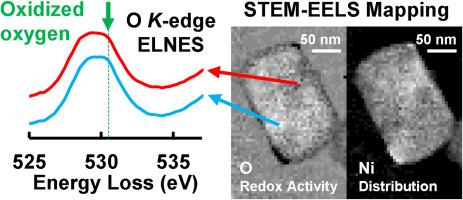富锂层状氧化物带电单个粒子内氧氧化还原活性空间波动的纳米尺度映射
IF 3.5
3区 化学
Q2 CHEMISTRY, INORGANIC & NUCLEAR
引用次数: 0
摘要
直接可视化富锂层状氧化物(LLO)单个(初级)颗粒中氧氧化还原活性的空间分布对于更深入地理解其反应机制至关重要。在这项研究中,我们提出了一种基于扫描透射电子显微镜(STEM)的电子能量损失谱(EELS)的实时空间映射方法来识别氧氧化还原活性域。在Li1+x(Ni0.3Mn0.7)1-xO2 (0 < x < 1/3)带电状态下,用EELS和软x射线吸收光谱(S-XAS)清晰地检测到电子释放氧(氧化氧)。tem - eels光谱成像明确了氧氧化还原活性的波动与LLO颗粒内Ni的分布密切相关,发现氧化氧的种类分布与Ni贫区有很好的相关性。过渡金属的不均匀分布导致颗粒中氧的不均匀活化,富镍结构域抑制氧氧化还原活性。这种在LLO单粒子水平上的氧活性域的真实空间映射有助于理解材料的机制。本文章由计算机程序翻译,如有差异,请以英文原文为准。

Nanoscale mapping of spatial fluctuations in oxygen redox activity within a charged single particle of Li-rich layered oxide
Direct visualization of the spatial distribution of oxygen redox activity in single (primary) particles of Li-rich layered oxide (LLO) is essential for a deeper understanding of its reaction mechanism. In this study, we propose a real-space mapping approach for identifying oxygen redox-active domains using scanning transmission electron microscopy (STEM)-based electron energy-loss spectroscopy (EELS). Electron-released oxygen (oxidized oxygen) was clearly detected by EELS and soft X-ray absorption spectroscopy (S-XAS) in the charged state of Li1+x(Ni0.3Mn0.7)1-xO2 (0 < x < 1/3). STEM-EELS spectrum imaging clarified that the fluctuations in oxygen redox activity closely correlate with the Ni distribution within LLO particles, found that oxidized oxygen species distribution was well correlated with Ni-poor region. The heterogeneous distribution of transition metals leads to non-uniform activation of oxygen in the particles, with Ni-rich domains suppressing oxygen redox activity. This real-space mapping of oxygen activity domains at the LLO single-particle level contributes to understanding the material's mechanism.
求助全文
通过发布文献求助,成功后即可免费获取论文全文。
去求助
来源期刊

Journal of Solid State Chemistry
化学-无机化学与核化学
CiteScore
6.00
自引率
9.10%
发文量
848
审稿时长
25 days
期刊介绍:
Covering major developments in the field of solid state chemistry and related areas such as ceramics and amorphous materials, the Journal of Solid State Chemistry features studies of chemical, structural, thermodynamic, electronic, magnetic, and optical properties and processes in solids.
 求助内容:
求助内容: 应助结果提醒方式:
应助结果提醒方式:


